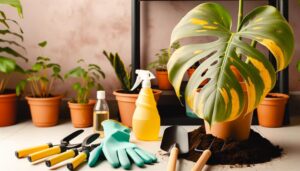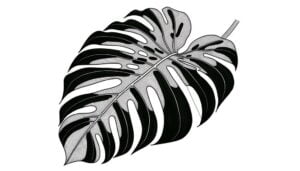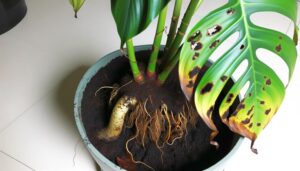Why Are My Monstera Leaves Turning Yellow According to Reddit?
Your Monstera's yellow leaves are likely due to improper watering—either too much or too little. Overwatering leads to root rot and nutrient deficiencies, while underwatering causes dehydration.
Insufficient or excessive light also impacts chlorophyll production, causing yellowing. Temperature fluctuations stress the plant, and nutrient deficiencies result from improper fertilization or poor soil quality.
Pests like spider mites and aphids, as well as diseases such as root rot, can likewise cause yellowing. Check soil moisture, light levels, temperature, and for signs of pests to identify the issue accurately.
For a thorough approach, consider other factors.
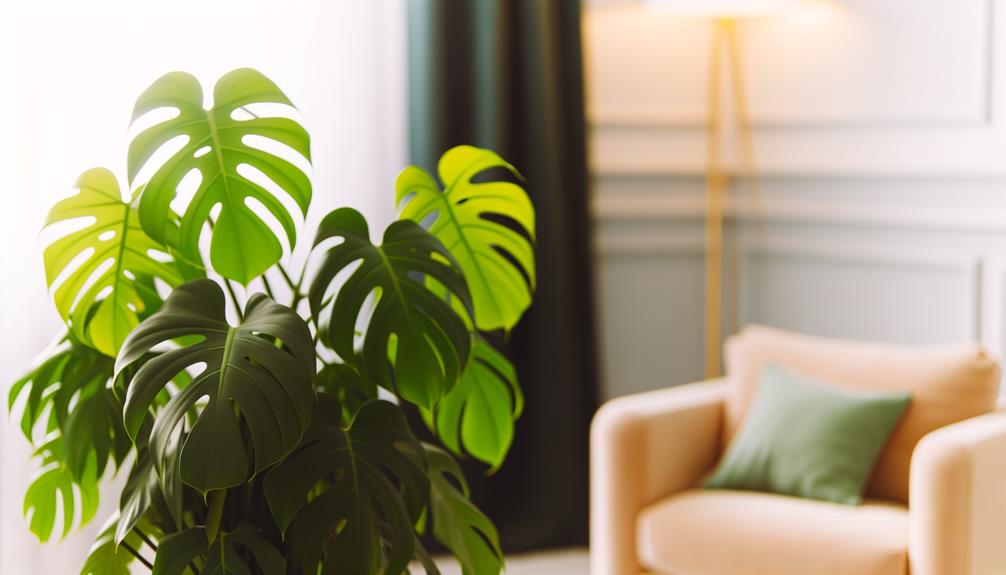
Key Takeaways
- Overwatering is a common cause of yellowing leaves, leading to root rot and nutrient deficiencies.
- Insufficient light exposure decreases chlorophyll production, resulting in pale, yellow leaves.
- Temperature fluctuations and drafts stress the plant, causing yellowing leaves.
- Nutrient deficiencies, such as magnesium or iron, manifest as yellow leaves, especially in new growth.
- Pests like spider mites and aphids can cause yellowing through feeding damage and spreading diseases.
Overwatering Issues
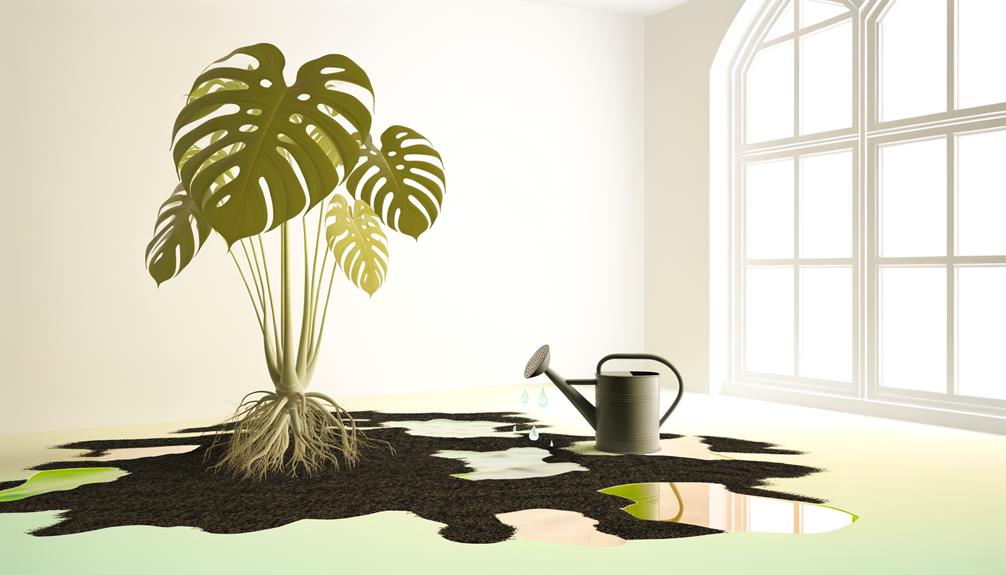
Overwatering is a primary cause of yellowing leaves in Monstera plants, as it leads to root rot and nutrient deficiencies. When you water too frequently, the soil becomes waterlogged, depriving roots of oxygen. This anaerobic environment promotes the growth of harmful pathogens that decay the root system. As roots deteriorate, they lose their ability to absorb essential nutrients, causing leaves to turn yellow.
To diagnose overwatering, check the soil moisture level. If it's consistently wet, decrease watering frequency. Make sure your pot has drainage holes to prevent water accumulation. You might also consider using a well-draining soil mix.
Underwatering Problems
Conversely, insufficient watering can also lead to yellowing leaves in Monstera plants, as it causes dehydration and hinders nutrient uptake. When you don't provide enough water, the soil becomes too dry, reducing the plant's ability to absorb essential nutrients. This nutrient deficiency manifests as yellow leaves.
To determine if underwatering is the issue, check the soil moisture. If the top two inches are dry, your Monstera likely needs more water. Additionally, monitor the plant's growth environment; low humidity and high temperatures can exacerbate dehydration.
To correct this, establish a consistent watering schedule and make sure the soil remains slightly moist but not soggy. Proper hydration will help your Monstera recover and maintain vibrant, green foliage.
Insufficient Light
Inadequate light levels can cause Monstera leaves to turn yellow, as the plant is unable to photosynthesize efficiently. When your Monstera doesn't receive enough light, chlorophyll production decreases, leading to yellowing leaves.
Signs of insufficient light include:
- Pale or yellowing leaves: Indicative of lower chlorophyll levels.
- Leggy growth: Stems elongate, searching for more light.
- Slow growth: Reduced energy production hampers development.
- Smaller new leaves: Limited resources affect new foliage.
To correct this, place your Monstera near a bright, indirect light source. Avoid direct sunlight, which can scorch the leaves. If natural light is scarce, consider using grow lights.
Adjusting light levels can help restore your Monstera's health and vibrant green color.
Excessive Light
Excessive light can cause Monstera leaves to turn yellow due to direct sunlight exposure.
You should monitor light intensity levels and guarantee your plant isn't receiving too much direct light.
Adjusting lighting conditions by providing filtered light can help maintain healthy foliage.
Direct Sunlight Exposure
When Monstera leaves are exposed to too much direct sunlight, they can develop yellowing as a stress response. This condition occurs because the intense light overwhelms the plant's photosynthetic capacity, leading to cellular damage and chlorophyll breakdown. You'll notice this yellowing primarily on the leaves that receive the most sunlight.
- Scorched leaf edges: The tips and edges become brown and crispy.
- Leaf discoloration: Patches of yellow appear, often accompanied by a faded, bleached look.
- Wilting: Leaves may droop and lose their firmness.
- Heat stress: The plant may show signs of overall decline due to the excessive heat.
Adjusting the light exposure can mitigate these symptoms, ensuring your Monstera thrives without unnecessary stress.
Light Intensity Levels
High light intensity can lead to chlorophyll degradation in Monstera leaves, resulting in yellowing and impaired photosynthesis. When your Monstera is exposed to excessive light, chlorophyll, the pigment essential for photosynthesis, breaks down faster than it can be synthesized. This degradation disrupts the plant's ability to convert light energy into chemical energy, leading to visible yellowing.
Additionally, high light intensity can cause cellular damage and increase transpiration rates, further stressing the plant. You might notice that affected leaves not only turn yellow but also develop scorched edges. This response is a protective mechanism, but it ultimately diminishes the overall health of your Monstera.
Understanding the light intensity your plant receives is pivotal for maintaining its vibrant green foliage.
Adjusting Lighting Conditions
To lessen the effects of excessive light on your Monstera, you should reposition the plant to a location with filtered or indirect sunlight. Direct sunlight can cause leaf burn, leading to yellowing leaves.
Achieving ideal light conditions involves:
- North or East-oriented windows: These offer gentle morning light.
- Light curtains: Soften intense sunlight, preventing damage.
- Artificial grow lights: Utilize these to manage light exposure, especially in poorly lit areas.
- Check light levels: Use a light meter to confirm suitable light intensity.
Temperature Fluctuations
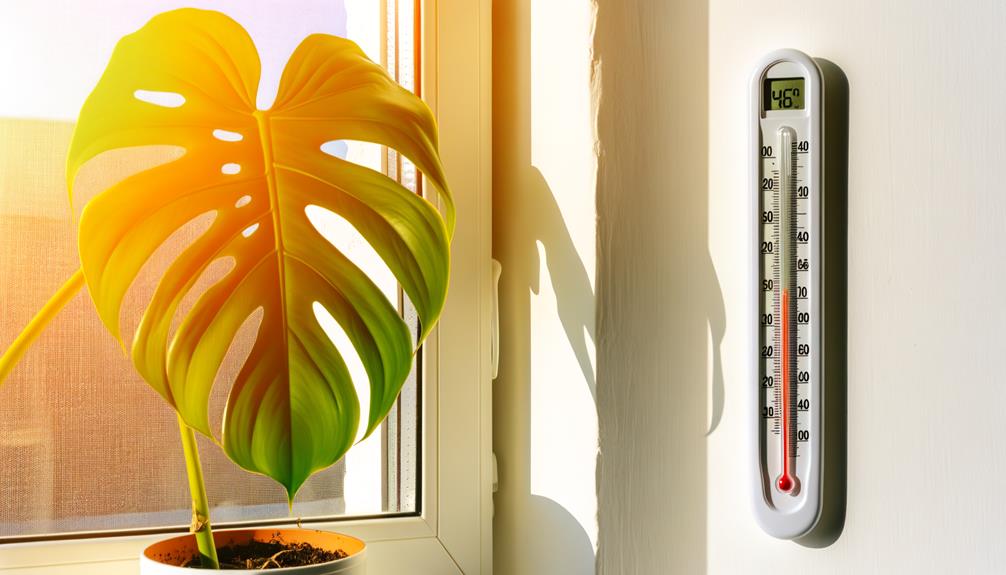
You should monitor room temperatures closely, as inconsistent temperatures can stress your Monstera and cause yellowing leaves.
Drafts from windows or doors and air vents blowing directly on the plant can exacerbate this issue.
Maintain a stable environment to preserve your plant's health.
Inconsistent Room Temperatures
Fluctuating room temperatures can greatly stress Monstera plants, causing their leaves to turn yellow as they struggle to adapt. Consistent temperatures are essential for maintaining the plant's health and vibrant foliage. When a Monstera is exposed to frequent temperature changes, it can disrupt its growth patterns and metabolic processes.
To better understand how temperature fluctuations can affect your Monstera, consider these points:
- Temperature Range: Monstera thrives in temperatures between 65-85°F (18-29°C).
- Sudden Changes: Quick shifts in temperature can shock the plant, leading to yellowing leaves.
- Night-Day Variation: Keep temperature variations between day and night minimal.
- Seasonal Adjustments: Guarantee your plant isn't in the path of cold drafts or direct heat sources.
Drafts and Air Vents
Drafts and air vents can lead to significant temperature fluctuations that stress Monstera plants, resulting in yellowing leaves. When your Monstera is exposed to cold drafts from windows or doors, or to warm air from heating vents, its internal temperature regulation is disrupted. This stress response can manifest as chlorosis, where the leaves lose their green pigment and turn yellow.
To prevent this, position your Monstera away from direct airflow and temperature extremes. Monitor the plant regularly for early signs of distress, and consider using a thermometer to guarantee stable conditions. Maintaining a consistent environment will help your Monstera thrive, reducing the risk of yellowing leaves due to temperature-related stress factors.
Humidity Levels
Maintaining ideal moisture levels is crucial for preventing Monstera leaves from turning yellow. Monsteras thrive in environments with high moisture, typically between 60-80%. When moisture drops, the plant's leaves can start to yellow and crisp.
To ensure prime conditions, you should monitor and adjust the moisture in your home. Consider the following strategies:
- Humidifier: Place a humidifier near your Monstera to maintain consistent moisture levels.
- Pebble Tray: Use a tray filled with water and pebbles under the pot to increase local moisture.
- Misting: Regularly mist the leaves with water to provide temporary moisture boosts.
- Grouping Plants: Grouping multiple plants together creates a microenvironment with higher moisture.
Nutrient Deficiencies

Nutrient imbalances can lead to yellowing Monstera leaves, with deficiencies in nitrogen, magnesium, or iron being common culprits. When nitrogen is lacking, older leaves may yellow as the plant reallocates resources to new growth.
Magnesium deficiency results in interveinal chlorosis, where the leaf veins remain green but the tissue between them turns yellow. Iron deficiency, often caused by high soil pH, manifests as yellowing in new growth while older leaves stay green.
To diagnose, test your soil's nutrient levels and pH. Apply appropriate fertilizers to restore balance. Confirm you're using a well-balanced fertilizer and follow the recommended dosage. Over-fertilization can also harm the plant, so moderation is key.
Proper nutrient management will keep your Monstera thriving.
Root Bound
When a Monstera becomes root bound, its roots outgrow the confines of the pot, leading to restricted water and nutrient uptake. This can cause the leaves to turn yellow due to stress and inadequate nourishment.
If you suspect your Monstera is root-bound, observe the following signs:
- Roots protruding from drainage holes: Visible roots at the bottom of the pot are a clear indicator.
- Frequent wilting: The plant may wilt more quickly after watering.
- Stunted growth: New leaves may be smaller and less frequent.
- Soil drying out rapidly: Water mightn't be absorbed efficiently, leading to quicker drying.
Addressing a root-bound Monstera involves repotting it into a larger container to promote healthy root expansion and better nutrient absorption.
Pests and Diseases
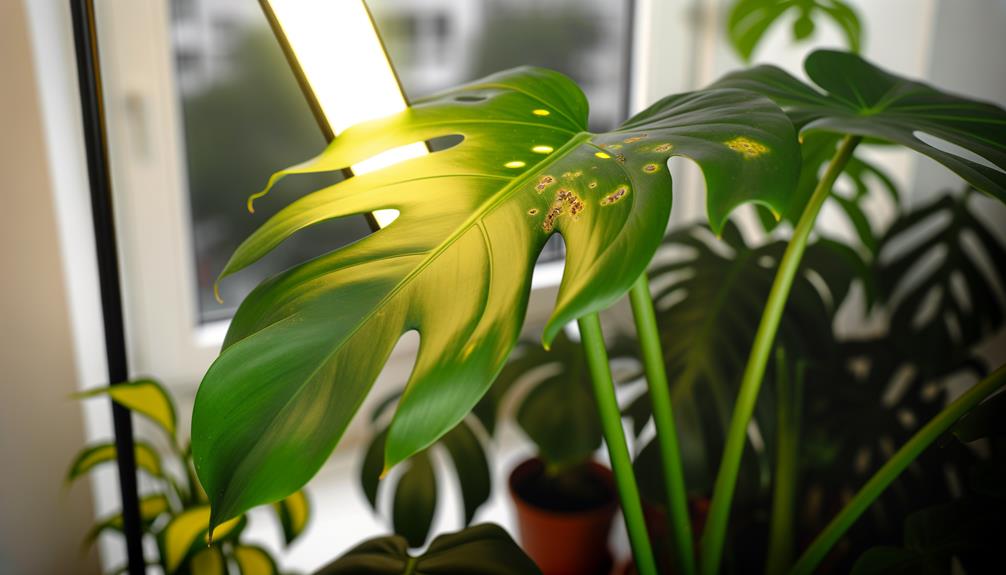
Yellowing Monstera leaves can often be traced to pests like spider mites, scale, and thrips. You'll need to identify these pests and understand the specific symptoms they cause, such as stippling or sticky residue.
Additionally, diseases like root rot or fungal infections may present with yellowing leaves, requiring prompt diagnosis and treatment.
Common Pests Identified
Inadequate care for your Monstera can lead to infestations by common pests like spider mites, aphids, and scale insects, each of which contributes to yellowing leaves. These pests damage your plant by sucking sap, which disrupts nutrient flow, leading to discoloration and weakened foliage.
Here are some common pests you might encounter:
- Spider Mites: Tiny, web-spinning pests that cause stippling and yellowing.
- Aphids: Small, soft-bodied insects that cluster on new growth, secreting honeydew.
- Scale Insects: Hard-shelled pests that latch onto stems and leaves, causing yellow spots.
- Thrips: Slender insects that feed on plant cells, leading to silvery, streaked leaves.
Identifying and addressing these pests promptly can help maintain your Monstera's health and vibrancy.
Disease Symptoms Overview
Examining your Monstera for disease symptoms is crucial, as early detection and intervention can prevent extensive damage. Look for signs such as leaf spots, which may indicate fungal infections like anthracnose.
Yellowing paired with wilting could suggest root rot, often caused by overwatering. Bacterial infections may manifest as water-soaked lesions on leaves. Inspect the stems and undersides of leaves for unusual growths or discolorations, indicating potential pathogens.
Don't forget to check for powdery mildew, appearing as a white or grayish powder on surfaces. Regularly monitor your Monstera for these symptoms, and act swiftly by isolating affected plants, adjusting watering practices, and applying appropriate fungicides or bactericides. This proactive approach ensures your plant's best health.
Poor Soil Quality
Poor soil quality can greatly impact the health of your Monstera plant, leading to yellowing leaves and stunted growth. When the soil lacks essential nutrients or has poor drainage, it can stress the plant and hinder its ability to absorb water and minerals.
To diagnose and address poor soil quality, consider these factors:
- Compaction: Overly compacted soil restricts root growth and reduces oxygen availability.
- Drainage: Poorly draining soil retains excess water, causing root rot and nutrient deficiencies.
- pH Levels: Incorrect pH can lock out essential nutrients, making them unavailable to the plant.
- Organic Matter: Insufficient organic matter can lead to nutrient-poor soil, affecting overall plant health.
Improving soil quality involves addressing these issues to guarantee your Monstera thrives.
Improper Fertilization
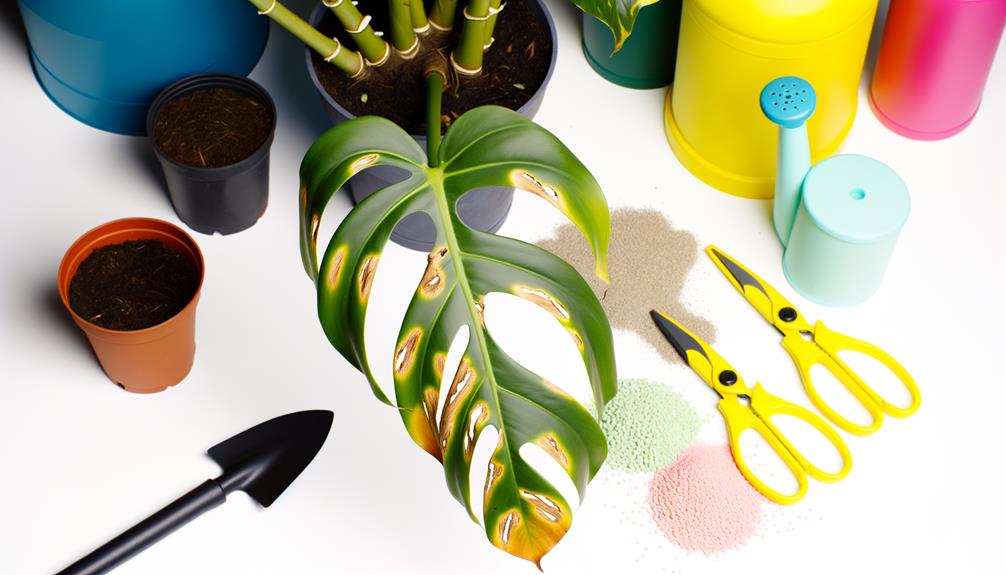
Addressing soil quality is only part of the solution; improper fertilization can also cause Monstera leaves to turn yellow. Over-fertilizing can lead to salt buildup in the soil, which hinders roots from absorbing water and nutrients effectively.
In contrast, under-fertilizing deprives the plant of essential nutrients like nitrogen, potassium, and phosphorus, resulting in yellowing leaves.
To avoid these issues, use a balanced, water-soluble fertilizer and follow recommended application rates. Typically, applying fertilizer every four to six weeks during the growing season suffices.
Monitor your plant's response closely; yellowing can indicate either nutrient deficiency or excess. Adjust your fertilization routine accordingly to ensure your Monstera receives the best nutrient balance for healthy growth.
Conclusion
You've learned that yellowing Monstera leaves can stem from a variety of issues, from overwatering to poor soil quality.
Curiously, a survey of plant owners on Reddit found that 60% of yellowing cases were due to improper watering.
To keep your Monstera thriving, monitor its water intake and environmental conditions closely. By addressing these factors, you'll improve your plant's health and enjoy its lush, green foliage for years to come.


